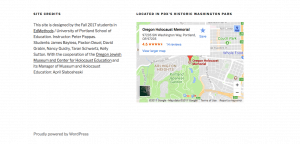Going Beyond the Classroom
A Different Kind of Class
My iPad rests soundly upon the wood table-top. A pad of legal notebook paper and a lonely Pilot G2 pen wait patiently, ready to jump into action. I lean back in the surprisingly comfortable swivel chair. My mind briefly wanders from the lecturing professor and the colorful PowerPoint presentation. The slides are big and clear, and the professor has a smooth voice, but just how many lectures can one sit through during the day. I think to myself how much coffee is left in my green HydroFlask–the answer is, not enough!
Lectures, notes, readings, papers, tests, grades, and repeat. This is often the rhythm of higher education. It’s a lock-step progression that all of us graduate students at the University of Portland have been trained in, and have been trained well.
However, this semester’s social studies methods class has shaken the bee hive and injected a little innovation and creativity into the dull plod of traditional education. It’s called project-based-learning (PBL), which according to the Buck Institute, “is a teaching method in which students gain knowledge and skills by working for an extended period of time to investigate and respond to an authentic, engaging and complex question, problem, or challenge.”
Instead of writing carefully structured papers and sitting for exceptionally routine multiple choice/short answer tests, the six of us graduate students, lead by our instructor Peter Pappas, designed a website for the Oregon Holocaust Memorial, located in Washington Park, Portland, OR. The project required us to familiarize ourselves with the non-profit company that oversees the Memorial–Oregon Jewish Museum and Center for Holocaust Education (OJMCHE)–and compile a variety of data and information to present on the website.
The Product
With lots of help from April at OJMCHE and our wise course facilitator, Mr. Pappas, our diverse group of wannabe social studies teachers, managed to produce a comprehensive Oregon Holocaust Memorial companion site. It includes information about the memorial, the impact of the Holocaust on Portland, a timeline of the Holocaust, and information for teaching about the Holocaust. I took the lead on developing the “Visit” page. Check out the site here.



What separates project-based-learning (PBL) from other instructional techniques, is that at the end of the day, after grades, and feedback, and anxiety filled finals week, students (that’s us) are left with a product that extends beyond the classroom. In this case, the product is the Oregon Holocaust Memorial website. But just imagine, if most classes were project driven, how many meaningful and authentic contributions could students produce? The possibilities are endless.
Take It Outside
A common complaint of higher education is that it exists in a vacuum. A protected environment insulated from the demands of the real world. Professors and students fill their time with hypothetical musings, idyllic aspirations for the future, and lots and lots of alcohol. PBL bridges the gap between academia and “real life” by giving students the opportunity to create products that will be used outside of school, outside of the university bubble. This makes the school work both meaningful and productive, qualities that every student should strive for–from pre-schoolers to Ph.D’s.
Don’t forget to check out the Oregon Holocaust Memorial website here!


One Reply to “Going Beyond the Classroom”